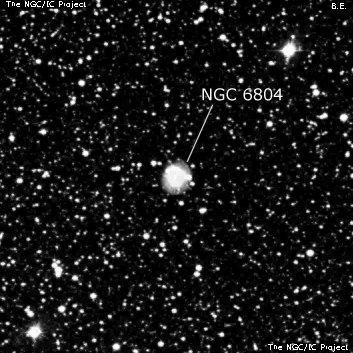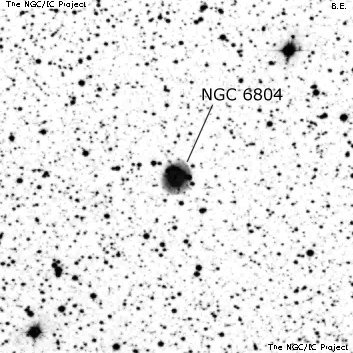NGC/IC Project Restoration Effort
(This is a very very beta version)
NGC6804


Basic Information
Location and Magnitude
Right Ascension: 19:31:35.4
Declination: +9:13:33
Constellation: AQL
Visual Magnitude: 12.0
Historic Information
Discoverer: Herschel W.
Year of discovery: 1791
Discovery aperture: 18.7
Observational
Summary description: cB, S, iR, rrr
Sub-type: PN
Corwin's Notes
=====
NGC 6804. Both WH and JH believed this to be a compact cluster of stars.
WH's observation, from the sweep of 25 August 1791, reads, "cB, S, iF, er,
some of the stars visible." Based on that, he put the object into his sixth
class, "Very compressed and rich clusters of stars," as number 38. His
position is good enough to identify the object as the planetary nebula
G045.7-04.5 with several of the superposed stars thrown into the mix. His
description suggests that he actually did see some nebulosity here.
JH picked this up on four nights. His descriptions are more or less
consistent:
21 Aug 1827: Doubtful if a resolved cl or a neb of first class. pL, R, bM,
60"; with 2 or 3 accidental stars of the Milky Way.
22 Aug 1827: A cluster. Has a * 16 m, one or two 18 m, and neb.
29 May 1829: A vS roundish cluster, 40" diam, of vS stars, one brighter
than the rest and = 15 m. It is like a nebula well resolved, and is a
curious object.
15 Aug 1830: A very small compressed fan-shaped cluster of stars 11...18 m,
diam = 1'; a * 11 m on the nf side forms the vertex of the fan.
My attention was caught because JH makes it clear that he is looking primarily
at a cluster of stars; it seems almost coincidental that a planetary nebula is
involved.
In any case, it is clear that both of the Herschel's considered this to be
primarily a cluster rather than a nebula. So, while I've given the position
of the planetary in the main table, I've also made it clear there that the NGC
object is actually an amalgam of the nebula and the superposed and nearby
stars.
Steve's Notes
=====
NGC 6804
24" (6/30/16): at 501x (unfiltered): bright, irregular planetary with interesting structure! The overall shape is roughly oval, extending WSW-ENE, ~0.7'x0.5'. The 14th magnitude central star is very easy. A brighter mag 12.5-13 star is along the rim on the northeast side and a fainter mag 14-14.5 star is at the west edge of the rim. The latter star has a mag 15-15.5 companion 12" SSW. Also a 10" pair of mag 14/15 stars is off the northeast side. The rim is brightest along thin 90¡ strips centered on the southeast and northwest side and weak or open on the southwest side. Along with the brighter star on the northeast end, this creates a "C" or horseshoe appearance with a darker center.
18" (7/11/07): at 450x this striking planetary appeared elongated 4:3 WSW-ENE, ~60"x45". Three stars are involved including the 14th magnitude central star. A mag 12.5-13 star is at the northeast edge of the halo and a mag 14.5 star is at the west edge with a mag 15 companion close southwest. The surface brightness is irregular; weakest on the southwest side and slightly brighter along the east side, giving a "horseshoe" appearance.
17.5" (7/11/99): at lower powers appears moderately bright, irregularly round, ~1' diameter with several stars involved or nearby. At 280x, the view is very unusual with three stars involved and others nearby. The brightest is a mag 12.5-13 star at the NE edge. The mag 14 central star is visible with direct vision. Finally, a mag 14.5-15 star is at or just off the west side. The planetary is slightly elongated 4:3 SW-NE with an irregular surface brightness. The rim appears brighter along the east and northeast side and weakest at the west edge. Nearby stars include a mag 13 star ~1.5' NE (nearly on a line with the central star and the star on the northeast edge) and a mag 15-15.5 star close south-southwest of the star at the west edge.
13" (8/5/83): moderately bright, elongated WSW-ENE. Unusual appearance as four faint stars are very near or involved including the faint mag 14 central star visible with averted vision. A mag 13 star is at the NE edge 27" from the center, a very faint mag 15 star is at west edge and a similar star is just NW. The rim is possibly slightly brighter on the east edge.



